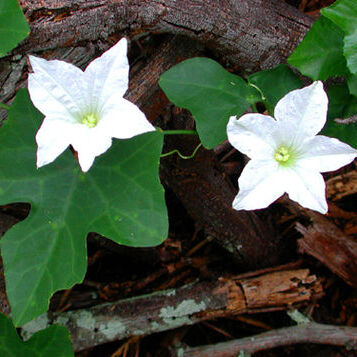Medium-sized climbers or trailers. Leaves simple, usually very variable in shape. Tendrils simple or proximally bifid. Probracts present. Flowers medium to large, orange-buff, yellow or brownish-yellow, rarely whitish, often green-veined, dioecious. Male flowers solitary, clustered or more usually shortly racemose; receptacle-tube relatively short and broad; lobes entire, often small and dentiform, less often large and calyx-like; corolla distinctly gamopetalous, 5-lobed; lobes entire and devoid of basal scales inside; stamens usually 3, all 2-thecous, sometimes two 2-thecous, one 1-thecous, more rarely stamens 2 or 4; filaments inserted on the tube, connate or coherent apically or sometimes along their whole length then forming a central column, less often free; anthers connate or more usually coherent at the base into a globose head, rarely free; connectives broad; thecae triplicate and usually also transversely ± convoluted. Female flowers solitary or rarely racemose; ovary smooth; ovules many, horizontal; stigma 3-lobed. Fruit small to moderately large, globose to elongate-cylindrical, fleshy, terete or less often longitudinally ribbed, baccate, indehiscent, with thin pericarp, red or red mottled with green. Seeds small, ± compressed, ovate in outline; testa fibrillose. Fig. 8.
Herbaceous or (sub)woody perennial climbers, early glabrescent; dioecious. Probract small, caducous. Tendrils unbranched (or elsewhere 2-branched). Leaves: blade simple, variable of shape. Flowers white (or creamy or orange, not in Malesia), petals fused into corolla-tube. Male flowers solitary (or 2 or 3), white (elsewhere yellowish); receptacle-tube cup-shaped; sepals 5, small; corolla campanulate, 5-lobed, lobes fused for c. 2/3, margin entire; stamens 3; filaments fused or free but tightly appressed forming a column, inserted at or near the base of the receptacle-tube; anthers two 2-thecous and one 1-thecous (elsewhere all 2-thecous), free but mostly coherent into a globular synandrium; thecae plicate; connectives broad; base of receptacle with a nectariferous disc (all species?). Female flowers mostly solitary; ovary ovoid or oblong, smooth or faintly ribbed, glabrous; ovules many, horizontal; stigmas 3, each 2-lobed. Fruit ripening red, berry-like, ellipsoid (elsewhere globose), moderate of size, pericarp thin. Seeds numerous, (ovate-)elliptic, compressed, margin distinct, edge entire.
Dioecious or (not in Australia) monoecious climbing or trailing annual or perennial herbs. Tendrils simple or 2-branched. Probracts present. Leaves simple, angled to palmately lobed. Male flowers solitary, fascicled or (not in Australia) in racemes; hypanthium broadly campanulate; calyx 5-lobed; lobes small; corolla 5-lobed, the lobes ovate, white or yellow; stamens 3, inserted at base of hypanthium; anthers fused into a column or coherent, two bilocular, one unilocular; disc absent. Female flowers solitary; perianth similar to male, usually smaller; staminodes 3, oblong or subulate; ovary globose to ellipsoidal, glabrous; ovules many, horizontal; stigmas 3. Fruit globose to ellipsoidal, fleshy, indehiscent, scarlet. Seeds many, ovate, compressed.
Herbs, climbing. Roots tuberous. Branches glabrous or slightly scabrous. Tendrils simple, rarely 2-fid. Leaf blade angled or divided. Plants dioecious or rarely monoecious. Male flowers solitary or in a cyme or raceme; calyx tube short, campanulate or turbinate; segments 5; corolla campanulate; segments 5; stamens 3, inserted at base of calyx tube; filaments connate; anthers connivent, one 1-celled, two 2-celled; anther cells reflexed; connective not produced. Female flowers solitary; calyx and corolla as in male flowers; staminodes 3, oblong or subulate; ovary ovoid, oblong, or linear; placentas 3; ovules numerous, horizontal; style filiform; stigma 3-lobed. Fruit ovoid or oblong, baccate, indehiscent. Seeds numerous, compressed, marginate.
Stamens usually 3, all 2-thecous, less often two 2-thecous, one 1-thecous; filaments inserted on receptacle-tube, usually ± connate or at least coherent into a central column; anthers connate or coherent into a globose head, rarely free; connectives broad; thecae flexuous.
Receptacle-tube usually short and broad, obconic-campanulate; lobes entire, often small, remote and dentiform, sometimes larger.
Fruit globose to ellipsoid-rostrate or cylindrical, usually terete, thin-walled, fleshy, bright red when mature.
Female flowers solitary or rarely racemose; ovary smooth; ovules many, horizontal; stigma 3-lobed.
Seeds ovate in outline, ± compressed; testa fibrillose or minutely rugulose, pale-coloured.
Flowers creamy-white to deep orange-yellow, sometimes with a pinkish tinge, dioecious.
Leaves simple, petiolate or sessile, usually very variable in shape.
Corolla distinctly gamopetalous, 5-lobed, lobes entire.
Male flowers solitary, clustered or shortly racemose.
Tendrils simple or proximally 2-fid.
Scandent perennial herbs.
Probracts present.

